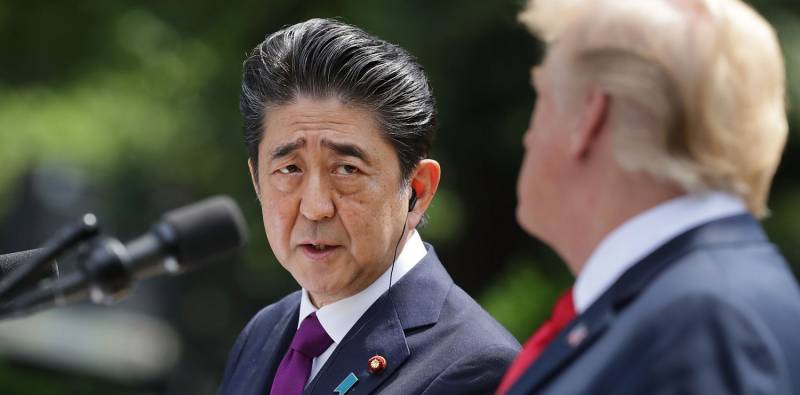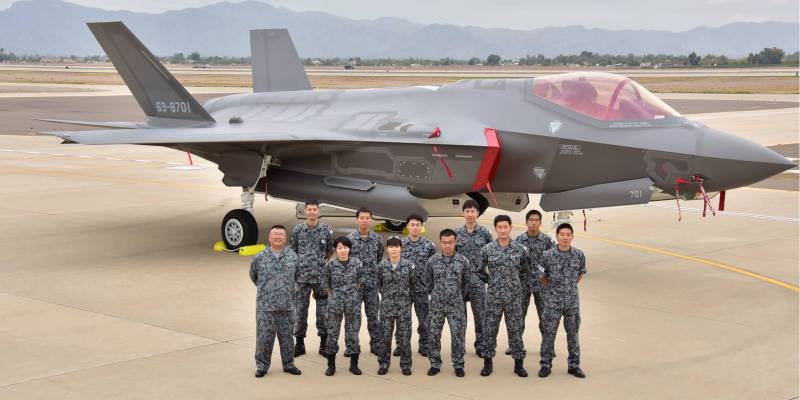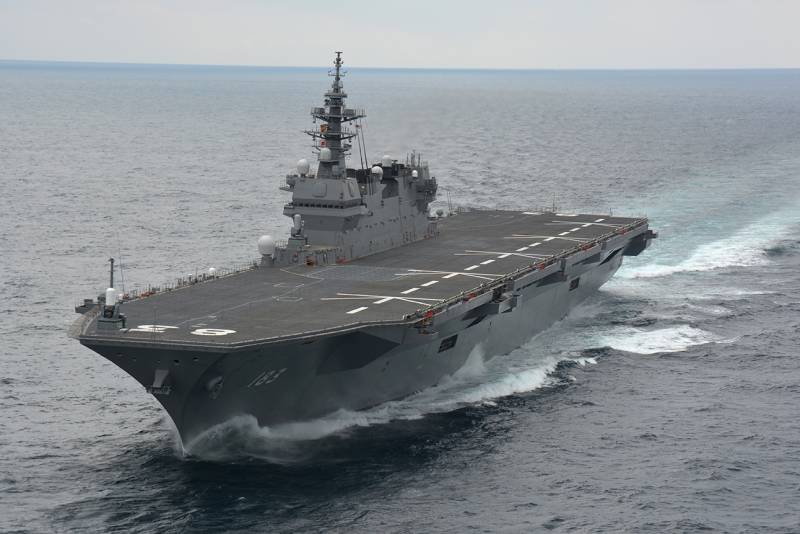Country of rising militarism
“The US remains the most powerful state in the world, but they have rivals, and we recognize the importance of strategic rivalry with China and Russia who are testing the regional order,” says the 10-year national defense plan, which was approved in mid-December 2018. Japanese government led by Prime Minister Shinzo Abe.
Also, according to The Japan Times, as part of the plan being implemented, Japan is going to strengthen its defense capabilities in space and cyberspace.
In total, over the next five years, Japan is going to spend at least 27,47 trillion yen (about 243 billion dollars) on armaments, which is 6,4 a percent more than the Land of the Rising Sun spent in the previous five-year period. At the same time, despite the impressive amount planned for spending, it can be noted that Japan spends only 1 percent of the country's GDP on defense, which, considering the size of the Japanese economy, still puts the country among the world leaders in terms of spending on armed forces. For comparison: Russia spends about 3 percent of GDP on its armed forces; At the end of 2017, Vladimir Putin said that Russia's military budget for 2018 would be 46 billion dollars.
For the first time, the Japanese Self-Defense Forces included space, as well as cyberspace, into the national defense plan for the next five years. Such measures should “fundamentally change the defense strategy,” which previously focused on land, air and sea areas. It is noted that the serious concern of official Tokyo is caused by the buildup of the military power of the PRC in the South China and other seas, as well as in cyberspace and space. The goal of strengthening the cybersphere in Japan is called the ability to resist possible attacks from abroad. At the same time, international law today does not contain a clear definition of cyber attacks, so it’s hard enough to understand exactly how and under what circumstances the Japan Self-Defense Forces will be able to start responding. In space, Tokyo expects to reduce the existing gap with other states. For the first time, a space unit will be created within the Self-Defense Forces of Japan. At the same time, the Japanese government intends to invest in the development of underwater unmanned vehicles and artificial intelligence technologies.
A serious increase in the armed forces of Japan is the increase in the number of fifth-generation Lockheed Martin F-35 Lightning II multi-purpose fighter-bombers purchased from the US. The plans of the Japanese command to increase the order to 142 machines had previously been reported by several Japanese media, including the Nikkei Asian Review, all of them referred to their own sources in the government and defense ministry. According to Japanese journalists, the authorities' plans to increase purchases of new American aircraft are directly related to the measures taken by the People's Republic of China to strengthen their army. In addition, the Japanese authorities give their answer to the demand of Donald Trump to acquire more American weapons. It is assumed that in the Japan Self-Defense Forces the X-NUMX-generation F-5 Lightning II will replace the existing F-35 fighter jets. The Japanese Air Force is armed with X-NUMX F-15 fighters, both American and Japanese, about half of this fleet cannot be upgraded.
Initially, Japan’s plans were limited to the purchase of 42-like aircraft, but later the government decided to increase the supply to 100 machines. At the same time, Japan acquires two types of 5 generation fighters: the F-35A and the F-35B with a short take-off and vertical landing. The cost of such a machine is about 88 million dollars. Japan is ready to send about a trillion yen (about 9 billion dollars) to acquire additional fighter-bombers. The first 42 fighter of the fifth generation, Japan should get to 2023 year, their deliveries to the country have already begun, the first F-35A was delivered back in 2016 year.
All airplanes of the first contract are F-35A fighter jets, intended for use with ordinary land airfields. Among the aircraft of the second batch will be machines F-35B with a shortened take-off and vertical landing. These 5 generation fighters are planned to be used as operational response forces, deploying even on small island airfields, including on islands in the East China Sea. But the greatest interest is the modernization of squadron destroyers-helicopter type "Izumo", which will be able to carry on board the fifth-generation fighter F-35B.
Today, Izumo-type helicopter carriers, with a total displacement of about 27 thousand tons, are the largest ships in Japan fleet since the second world war. The transformation of these two helicopter carriers into two light aircraft carriers, equipped with the latest fifth-generation fighter-bomber, is able to seriously change the balance of forces in the region. As they say in Odessa, a Izumo-type helicopter carrier and a Izumo-type aircraft carrier are two big differences. Currently, the Japanese Maritime Self-Defense Forces have two such helicopter carriers: Izumo and Kaga. It is believed that their air group can consist of 14 SH-60K SeaHawk helicopters, while the maximum size of the air group, based on the size and displacement of the ships, can be up to 28 aircraft (helicopters, convertiplanes and fighters).
The fact that Japan is ready for the first time since 1945 to put the plane aboard the ship was recently written by the South China Morning Post. According to the publication, on Tuesday, December 11, representatives of the ruling parties in Japan approved the proposal of the government to allow the use of helicopter carriers for transporting aircraft, as well as when it becomes necessary to convert these ships. In particular, we are talking about the modernization of the Izumo-class destroyers-helicopter carriers. According to Reuters, the new five-year national defense plan provides for the purchase of 18 fighters for deployment on Izumo modified helicopter carriers, as well as the purchase of two Aegis missile defense systems in the United States in order to effectively counter the threat from North Korea, and four tankers Boeing KC-46 Pegasus to expand the capabilities of the Japanese aviation.
Leading aviation experts polled by the specialized edition defensenews.com agree that, first of all, the increase in the number of F-35 fighter-bombers is a strong signal to China and the answer to its fifth generation fighter program. According to experts, Japan lives in a rather difficult situation, the Japanese cannot afford to conduct direct military actions, their only way is to build up their military potential, and the presence of 5-generation stealth fighters will help to more effectively restrain the PRC. In addition, the presence of fifth-generation airplanes in Tokyo, which will be based on sea carriers, will create a big tangle of problems for Beijing. With such military capabilities, Japan will be able to pursue a more assertive and muscular foreign policy in the Asia-Pacific Region (APR).
Above all, the large Japanese program for acquiring F-35 fighter-bombers is extremely beneficial for the United States, which does not receive economic dividends as much as the opportunity to coordinate its naval forces, the Marine Corps and Japanese self-defense forces, even more closely. And the presence of a large number of fifth-generation fighter jets in this region will allow collecting more intelligence data in the APR.
The national defense plan for the next five years also talks about the commissioning of three new ship-based UAV systems, but no details are disclosed in this regard. Most likely, they are referring to UAS vertical takeoff and landing systems designed for operations from the sides of 8 multi-purpose destroyers of a new class currently under construction. It is only known that earlier back in 2016, the Japanese military was interested in multi-purpose drones The Northrop Grumman MQ-8 Fire Scout (unmanned helicopter) is American-made, but nothing is known about the existence of any contractual obligations in this regard. In addition to drones, the Japanese fleet should be replenished with new aircraft and helicopters. It is planned to purchase twelve Kawasaki P-1 anti-submarine patrol aircraft, three Kawasaki C-2 transport aircraft and three CH-47JA Chinook heavy helicopters, which are assembled in Japan under license by Kawasaki.
Information sources:
https://lenta.ru/news/2018/12/18/usileniye
https://www.business-gazeta.ru/news/406716
https://vpk.name/news/237839_novyii_yaponskii_zakaz_na_f35_mozhet_imet_mnogo_effektov.html
https://www.defensenews.com/global/asia-pacific/2018/12/19/japan-seeks-drones-subs-f-35-jets-as-part-of-243-billion-defense-spending-plan
Open source materials



Information